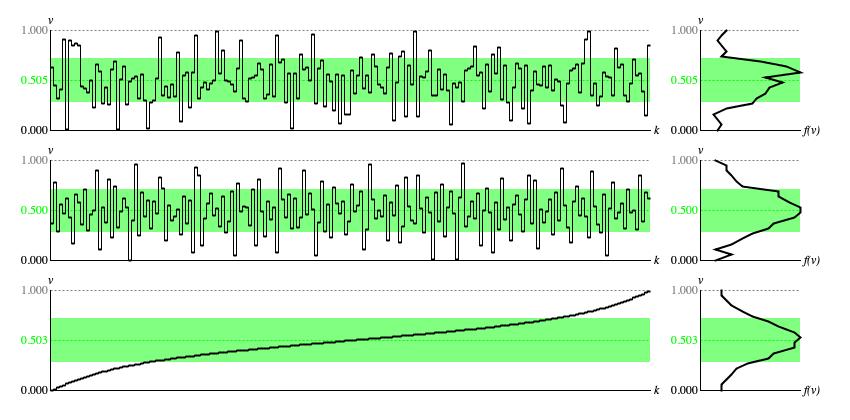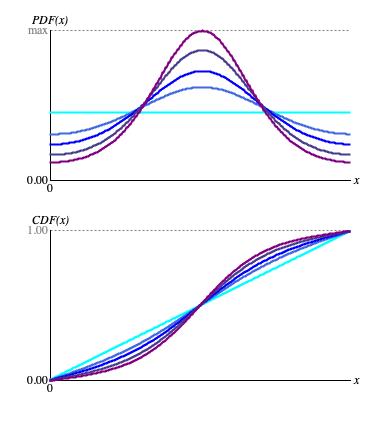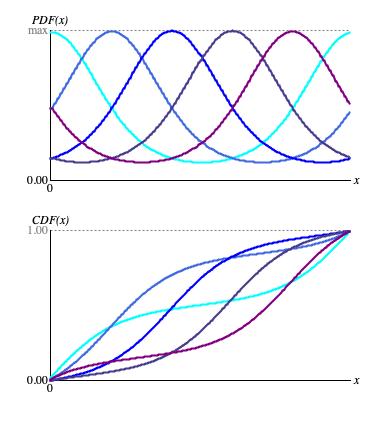Cosine-Exponential Transform1
Introduction
The ContinuousCosexp transform adapts
values from the driver domain to a bounded range which is regarded as one full
turn of a circle. The relative concentrations are calculated relative to the .
The range of values output by ContinuousCosexp.convert() is
controlled by two parameters implemented as Java fields: minRange and
maxRange. These have the restriction that
minRange < maxRange. It is strongly
recommended that minRange be zero.
The shape of the distribution curve is
controlled by two additional parameters: turns (symbolized φ)
and ratio (symbolized ρ). The turns
parameter is restricted to the range from zero to unity. The ratio
parameter must not fall below unity.
Each ContinuousCosexp instance internally maintains a
ContinuousDistribution instance
which divides the range from zero to unity into trapezoids of width
1/itemCount. The trapezoid height for sample value
z is calculated using the formula:
Math.pow(base, Math.cos(z + turns))where
base = Math.sqrt(ratio)
Notice that this formula has a minimum of 1/√ρ when
cos(z+turns)=-1
and a maximum of √ρ when
cos(z+turns)=1. Therefore
the max/min ratio is √ρ/(1/√ρ) = √ρ×√ρ = ρ.
The convert() method maps a value x
in the driver domain from zero to unity into a value v in the application-range
from minRange to maxRange in two
steps.
The first step uses ContinuousDistribution.quantile()
to recast the driver value x into an intermediate value
z, also between zero and unity.
The second step applies the
linear interpolation
formula:
v = (maxRange-minRange)*z + minRange.
The cosine-exponential distribution was invented by me2 — which does not preclude the possibility of it having been invented before by someone unknown to me. Thus Wikipedia supplies neither parametric mean μ nor parametric variance σ2 for this distribution.
Profile
Figure 1 illustrates the influence which
ContinuousCosexp.convert()
exerts over driver sequences when turns is 0.5 and
ratio is 5. This panel was created using the same driver sources used for the
ContinuousUniform,
which earlier panel provides a basis for comparison.

Figure 1: Panel of
ContinuousCosexp output from three different
Driver sources. Each row of graphs provides a time-series graph of samples (left)
and a histogram analyzed from the same samples (right).
The first row of graphs was generated using the standard random number generator. The second
row was generated using the balanced-bit generator. The third row was generated using an ascending sequence of driver values,
equally spaced from zero to unity.
The standard-random time-series graph (top row of Figure 1) has the same relative ups and downs as the standard-random time-series graph prepared for
ContinuousUniform, but the
specific values are squinched up toward the upper range bound. This difference becomes much clearer in the standard-random
histogram, where the whitespace separating the vertical v axis from the
smallest f(v) value progressively increases as v
increases from zero to unity. Notice that while these histogram peaks and valleys are similar to those derived for
ContinuousUniform, they
are not the same. The fact that values squinch upwards means that range values which fell into the bottommost histogram
region in the uniform histogram were spread across the bottom three regions here in the cosine-exponential histogram. Likewise the range
values which fell into the topmost histogram region here were spread across three regions in the uniform histogram.
The balanced-bit time-series (middle row of Figure 1) likewise has the same ups and downs as the balanced-bit time-series graph prepared for
ContinuousUniform with
values squinched similarly. Since balanced-bit sequences strive aggressively for uniformity, the histogram peaks and
valleys are comparatively restrained.
The time-series graph generated using ascending, equally spaced driver values (bottom row of Figure 1) presents the quantile function for this instance of a cosine-exponential distribution. The histogram of sample values presents the distribution's probability density function or PDF. The PDF is an equal-ratios curve bending upward from f(v) = 1 when v = 0 to f(v) = 3 when v = 1. Looking back at the time-series graph, notice how the quantile function rises more steeply where the distribution is rarefied and less steeply where the distribution is concentrated.
For each graph in Figure 1 the average sample value is plotted as a dashed green line, while the interval between ± one standard deviation around the average is filled in with a lighter green background. For the ideally uniform driver values plotted in the third row of graphs, the average sample value is 0.503 and the standard deviation is 0.217. The interval from 0.719-0.217 to 0.719+0.217 is 2*0.217 = 0.434 = 43% of the full application range from zero to unity. Since the continuous uniform distribution had 58% of samples within ± one standard deviation of the mean, this suggests that with the cosine-exponential distribution with ratio 5 is squeezing 58% of samples into 43% of the application range, giving a concentration rate of 58/43 = 1.35.
Cosine-Exponential Probability Curves

━ ρ = 1, ━ ρ = 2, ━ ρ = 3, ━ ρ = 5, ━ ρ = 8
Figure 2 (a): Cosine-Exponential distribution curves for φ = 0.5 (180°).
Figures 2 (a) through 2 (b) show how changes in parameter settings affect the distribution curves. Each figure provides two graphs. The upper graph shows the probability density function or PDF. The lower graph shows the cumulative distribution function or CDF.
Figure 2 (a) fixes the turns at φ=0.5, centering the
peak horizontally over the range. The ratio ranges from ρ=1 (━),
which produces no peak at all, through ρ=2 (━), ρ=3 (━),
and ρ=5 (━) to ρ=8 (━), where the
peak is most prominent.

━ φ = 0.0, ━ φ = 0.2, ━ φ = 0.4, ━ φ = 0.6, ━ φ = 0.8
Figure 2 (b): Cosine-Exponential distribution curves for ρ = 8.
Figure 2 (a) fixes the ratio at ρ=8 in
order to show how the value of φ positions the peak over the range. Notice that each increment to φ
shifts the peak rightward one fifth of the way along the range. Understand that φ=1.0 (not shown) would produce the same
graph as φ=0.0.
Coding
ContinuousCosexp implementation class.
The type hierarchy for ContinuousCosexp is:
-
TransformBase<T extends Number> extends WriteableEntity implements Transform<T> -
ContinuousDistributionTransform extends TransformBase<Double> implements Transform.Continuous -
BoundedTransform extends ContinuousDistributionTransform -
ContinuousCosexp extends BoundedTransform
Class ContinuousDistributionTransform embeds a
ContinuousDistribution
instance capable of approximating most any continuous distribution as a succession of trapezoids.
Each ContinuousDistribution trapezoid item has
left, right, origin,
and goal fields.
Understand that the succession of trapezoids ranges from zero to unity, not minRange to
maxRange. The trick with leveraging ContinuousDistribution
instances is that the trapezoids need recalculating every time a parameter changes. Updating one single trapezoid item is
not that big a deal, but more typically the number of will be 20 or more (my canned Normal distribution uses 200 trapezoids); also, the calculating
formulas often include exponents. So it makes sense to abstract the range boundaries out of the distribution and to apply range scaling
separately.
The distributing step of conversion happens in ContinuousDistributionTransform,
where the convert() method does this:
return getDistribution().quantile(driver);
Range scaling happens in BoundedTransform,
where the convert() method does this:
return interpolate(super.convert(driver));
And BoundedTransform.interpolate(factor)
does this (ignoring pesky initialization checks):
return (maxRange-minRange)*factor + minRange;.
TransformBase maintains a valid field
to flag parameter changes. This field starts out false
and reverts to false with every time ContinuousCosexp
calls TransformBase.invalidate(). This happens
with any change to alpha, beta,
or itemCount. Any call to TransformBase.getDistribution()
(and ContinuousDistributionTransform.convert() makes such a call) first creates
the distribution if it does not already exist, then checks valid. If false,
then getDistribution() calls validate(), which is
abstract to TransformBase but whose implementation is
made concrete by ContinuousCosexp. And that particular implementation of validate()
makes use of ContinuousDistribution.calculateBeta(alpha, beta, itemCount) to recalculate the
succession of trapezoids.
Comments
- The present text is adapted from my Leonardo Music Journal article from 1991, "A Catalog of Statistical Distributions". The heading is "Beta", p. 63
- A graph appears in my Interface (now Journal of New Music Research) article from 1986, "Two Pieces for Amplified Guitar" p. 39.
| © Charles Ames | Page created: 2022-08-29 | Last updated: 2022-08-29 |